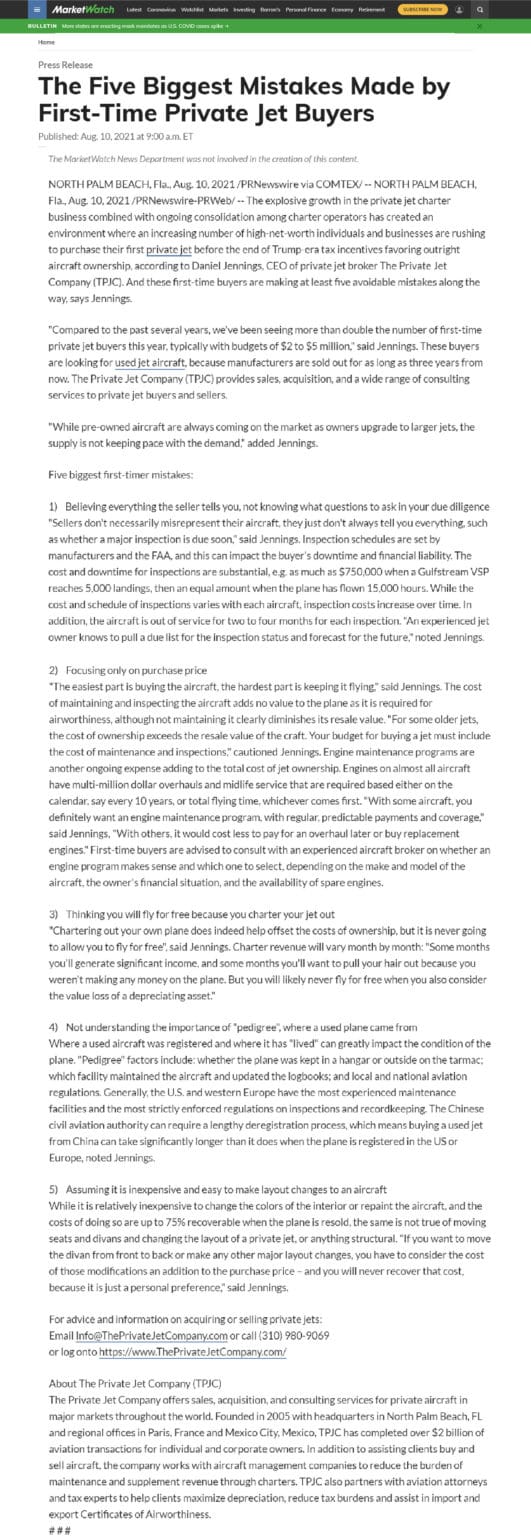
North Palm Beach, FL, Aug 10, 2021 – The explosive growth in the private jet charter business combined with ongoing consolidation among charter operators has created an environment where an increasing number of high-net-worth individuals and businesses are rushing to purchase their first private jet before the end of Trump-era tax incentives favoring outright aircraft ownership, according to Daniel Jennings, CEO of private jet broker The Private Jet Company (TPJC). And these first-time buyers are making at least five avoidable mistakes along the way, says Jennings.
“Compared to the past several years, we’ve been seeing more than double the number of first-time private jet buyers this year, typically with budgets of $2 to $5 million,” said Jennings. These buyers are looking for used jet aircraft, because manufacturers are sold out for as long as three years from now. The Private Jet Company (TPJC) handles private jet sales, acquisition, and a wide range of aircraft consulting services to private jet buyers and sellers.
“While used aircraft are always coming on the market as owners upgrade to larger jets, the private jet supply is not keeping pace with the demand,” added Jennings.
Five biggest first-timer mistakes
“Sellers don’t necessarily misrepresent their aircraft, they just don’t always tell you everything, such as whether a major inspection is due soon,” said Jennings. Inspection schedules are set by manufacturers and the FAA, and sellers are not required to disclose this information. The cost and downtime for inspections are substantial, e.g. $750,000 when a Gulfstream [model number?] reaches 5,000 landings, then an equal amount when the plane has flown 15,000 hours. While the cost and schedule of inspections varies with each aircraft, private jet inspection costs increase over time. In addition, the aircraft is out of service for two to six months for each inspection. “An experienced jet owner knows to ask about inspections,” noted Jennings.
“The easiest part is buying the aircraft, the hardest part is keeping it flying,” said Jennings. The cost of maintaining and inspecting the aircraft adds no value to the plane, although not maintaining it clearly diminishes its resale value. “For some older jets, the cost of ownership exceeds the resale value of the craft. Your budget for buying a jet must include the cost of maintenance and inspections,” cautioned Jennings. Engine maintenance programs are another ongoing expense adding to the total cost of jet ownership. After a certain amount of time, engines need to be overhauled – costing millions of dollars, the single largest expense. “With some aircraft, you definitely want an engine maintenance program, with regular, predictable payments,” said Jennings, “With others, it would cost less to pay for an overhaul later.” First-time buyers are advised to consult with an experienced aircraft broker on whether an engine program makes sense and which one to select, depending on the make and model of the aircraft, the owner’s financial situation, and the availability of spare engines.
“Chartering out your own plane does indeed help offset the costs of ownership, but it is never going to allow you to fly for free”, said Jennings. Charter revenue will vary month by month: “Some months you’ll make lots of money, and some months you’ll want to pull your hair out because you weren’t making any money on the plane. But you will never fly for free.”
Where a used aircraft was registered and where it has “lived” can greatly impact the condition of the plane. “Pedigree” factors include: corrosion from sea air; abrasion on mechanical components caused by sand in a desert locale; whether the plane was kept in a hangar or outside on the tarmac; how often hangars, runways and other infrastructure are cleaned; and local and national aviation regulations. Generally, the U.S. and western Europe have the most strictly enforced regulations on inspections. The Chinese civil aviation authority requires a lengthy deregistration process, which means buying a used jet from China can take ten times longer than it does when the plane is registered in the US or Europe, noted Jennings.
While it is relatively inexpensive to change the colors of the interior or repaint the aircraft, and the costs of doing so are up to 75% recoverable when the plane is resold, the same is not true of moving furniture, changing the layout of a private jet, or anything structural. “If you want to move the sofa from front to back or make any other layout changes, you have to consider the cost of those modifications an addition to the purchase price – and you will never recover that cost, because it is just a personal preference,” said Jennings.
